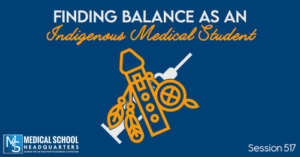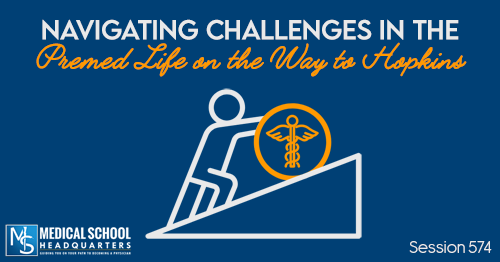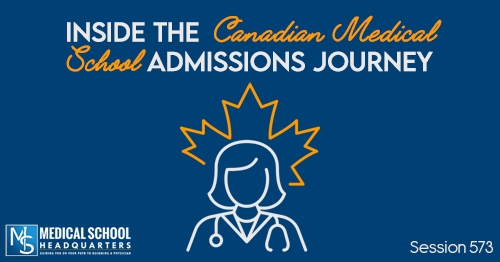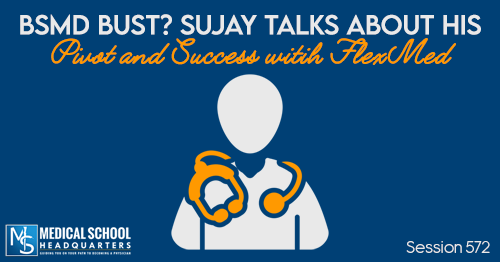Apple Podcasts | Google Podcasts
Session 517
Join me as I speak with an indigenous medical student, Victor, who was inspired to pursue medicine after noticing the lack of access in his tribal community.
For more podcast resources to help you with your medical school journey and beyond, check out Meded Media.
Listen to this podcast episode with the player above, or keep reading for the highlights and takeaway points.
[01:06] The MCAT Minute
The MCAT Minute is brought to you by Blueprint MCAT.
If you haven’t yet, check out The MCAT Podcast for more MCAT resources, tips, and strategies. It’s a free podcast that you can listen to whenever, wherever.
[02:12] Interest in Becoming a Physician
When Victor was in middle school, he got injured from a burn accident. He ended up getting three skin grafts and being in the hospital for two months. Without any healthcare nearby, he had to travel from their community by car. It made him realize the cost of lack of access to medical care in indigenous communities. This became one of the driving forces behind his passion to help which also led him to become a doctor.
Many of his family members were activists for indigenous rights, and in many ways, that included health because they’re closely intertwined. And so, he grew up going to protests, and always at meetings. His family gathered with indigenous peoples all over the country and all over the world. So he was hearing about the health issues just secondhand, as a kid, along with the other kids.
Victor says he didn’t meet a native physician until his junior year of undergrad. And that was a big moment for him because he realized it was something he wanted to do. Not having the blueprint or the rule book, seeing that native physician gave him the confidence he needed to pursue medicine.
“If you can see yourself in a position, it creates a lot more opportunity in your mind. It opens up your mindset.”
[08:24] Premed Struggles
Victor found his first two years to be the most difficult for him as he was still getting used to the environment. Coming from an underfunded high school in a poor neighborhood, they were primarily poor, Latino native students. So he felt that the educational quality was not commensurate with what it’s like to be an undergrad.
This hit Victor because he didn’t feel like he had the academic tools. It was difficult for him to adapt, especially being far from his native community. So he tried to figure out how to adapt to the new situation, going out into the community, finding his own community, and finding indigenous connections.
In short, his first two years in undergrad was more of a survival mode. His main priority is to be able to stay afloat by keeping his grades up no matter how difficult it was to handle workload. That, on top of the need to get enough sleep and create healthy patterns because sometimes, he would have to overwork himself.
He also admits to having test anxiety because again, he wasn’t used to the high rigor of examinations before in his high school.
Victor was aware that from the outside, people might have thought his chances would be slim because of how he was doing. He recognized some truth in what they’re seeing and that he was struggling. He knew he had weaknesses he needed to address so he had to figure out how to address them.
[16:32] Heavy Involvement in the Indigenous Rights Space
Victor set a realistic goal to show medical schools who he was outside of his scores and grades. He got involved in leadership, especially coming from almost a legacy of indigenous rights organization and activism. He focused almost completely on that, and making connections in the indigenous rights space. As a result, he was brought to many places that opened up so many opportunities.
He started getting involved in the United Nations. From his first year of undergrad up to this day, he became more and more involved in the United Nations and indigenous rights work there. This showed medical schools that he was super serious about health issues that weren’t impacting his community and he was out there trying to do something about it.
“I was someone who had strong connections to where I came from, and I was doing this all on behalf of those connections.”
He oftentimes finds himself being the only one speaking up because the numbers weren’t there. Yeah. And if there were more of them in the institution, that would allow them to support one another.
[22:40] A Commitment to Developing Solutions
Citing statistics, Victor saw that only 11% of medical schools have curriculum on indigenous health and they’re the least represented race in medicine.
There was an anti-racism medicine course at Harvard Medical School, and Native Americans were completely missing from the curriculum over eight weeks, with no mention of them. It was one of those instances where he had to speak up. And that’s just one of the many instances. Still to this day, in medicine, he is often the only one there to say something.
“Natives are still quite invisible in the field of medicine, not only by numbers, but even our health issues.”
Over time, Victor has also developed better strategies to do it and figuring out effective pathways to go down. Sometimes, too, it means figuring out when he shouldn’t do it to conserve his energy. For instance, he is studying for Step 1 so he is working on the backend of things, focusing on building solutions.
He didn’t want to be someone who just talked about problems, but someone who has real solutions. Victor has been focusing at Harvard Medical School in developing indigenous health curriculum for the school. He has co-founded a pipeline program for native youth from tribal colleges to Harvard Medical School.
[28:19] What the Future Looks Like for Him
Victor wants to work with Native youth from his community and have a clinical practice where they can see him outside of that, with whatever free time he has. He’s going to continue to advocate for policy solutions. That might be at the community level or at the international level at the UN as well.
But one of the ways that he has become attached to, in terms of being able to advocate for issues in the public sphere, is through writing. He has yet veered towards writing as a mode of his own sort of advocacy. Where he could still be in the clinic and then be able to put out an article every couple of weeks on an issue that our people are facing that impacts our health.
[31:01] Final Words of Wisdom
Message for Students from Indigenous Background
Never give up. Keep fighting. Don’t let anybody stand in your way, in terms of telling you that you can’t do something. It’s never too late. Maybe you always wanted to be a doctor, but you had to start taking care of your family and you weren’t able to go to undergrad. If that is your dream, it’s never too late to figure out how to achieve that.
There are so many different pathways. Victor found community colleges as one of the best pathways for disadvantaged students who often face a nonlinear pathway. Community colleges often have all the premed requisites that you need to apply to medical school, and they are affordable.
Tribal Colleges are another great pathway into any of the health professions. And so, just keep pushing. We face a lot of challenges in this world. But we also come from really strong and resilient people. And that is passed on to us as well. So we can do what we need to do for our communities. We can achieve that.
Message for the Non-Indigenous People in Medicine
Victor recommends helping to get more natives in the room, more natives in medical school, and more native faculty. There are so many solutions Victor says he could give, but the reality is there are over 500 unique tribal nations in the U.S. and he only comes from two of them.
Victor emphasizes the need for more of them in the room because they have a unique understanding of the issues that communities face. That creates so much potential for impact in medicine right now.
“A lot of those solutions are not at the table. They’re not being brought to the table because the people aren’t at the table.”
At the end of the day, we have to figure out how to push in new institutions for greater recruitment and support of indigenous medical students, of indigenous premedical students, and recruiting indigenous faculty as well.
Links:
Instagram: @vlocarmen
Twitter: @vlocarmen












